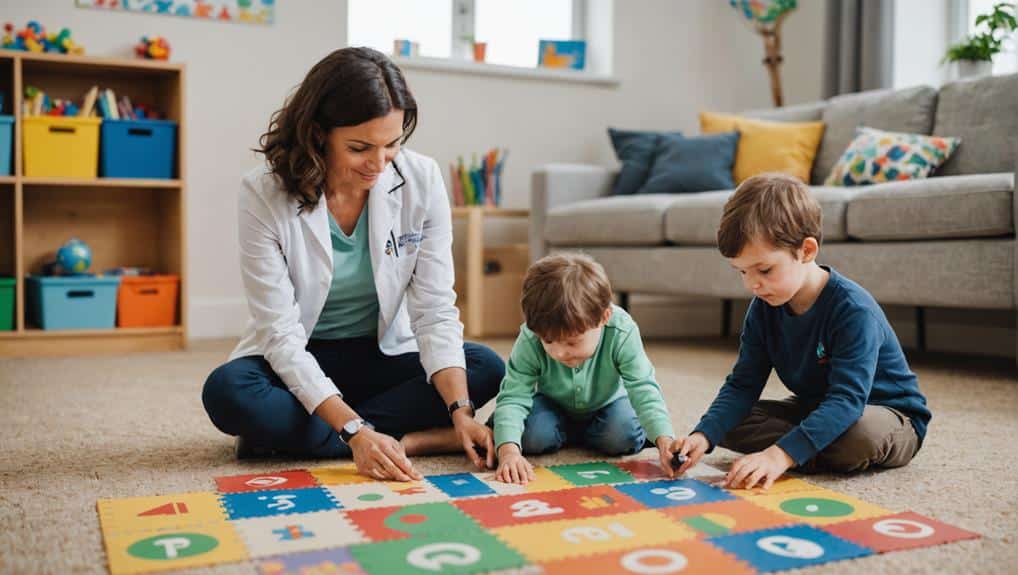Experts are discussing the use of DIRFloortime for autism therapy. This approach focuses on interactive play and building strong emotional connections to support children with Autism Spectrum Disorder (ASD). It aims to help children develop essential skills like communication and social interaction.
While each child and family is unique, and various methods have pros and cons, DIRFloortime offers a gentle, relationship-based approach that respects a child’s natural emotional interests. It helps create meaningful connections and encourages emotional and social development in a supportive, playful environment.
Key Takeaways
- DIR/Floortime is a developmental approach designed to aid children with Autism Spectrum Disorder (ASD).
- It emphasizes child-led play and interaction to advance social, developmental, and intellectual capacities.
- The therapy aims to build foundational skills for higher-level abilities, including emotional regulation and social communication.
- Implementing DIR/Floortime involves parent or caregiver participation, following the child’s lead in a child setting.
- Despite potential benefits, critics argue that DIR/Floortime lacks empirical evidence and questions the generalizability of the skills learned.
Understanding DIR/Floortime Approach
In autism therapy, the DIR/Floortime approach is a highly beneficial method developed by Stanley Greenspan, M.D., and Serena Wieder, PhD in the 1980s. This relationship-based therapy centers on development, play, and interaction for children with autism spectrum disorders. By focusing on child-led play, DIR/Floortime recognizes that play is essential for social, cognitive, and physical development in autistic children. Its strength lies in following the child’s natural developmental path, allowing therapists to gently challenge them without causing unnecessary stress. This approach creates a supportive environment where children can face and overcome developmental challenges, similar to how a secure and encouraging setting enhances therapeutic play in sensory integration techniques.
At the heart of DIR/Floortime is expanding ‘circles of communication.’ This method encourages back-and-forth interaction, improving the child’s social, developmental, and intellectual capacities. This approach is not a solitary effort but requires significant parent involvement—parents engage in the child’s activities or child or floortime sessions for 2 to 5 hours, emphasizing inclusion with peers.
Critical Principles of ICDL DIR/Floortime
Building upon the foundational understanding of the DIR/Floortime approach, we now focus on its fundamental principles. This model is built on the premise that children thrive within the context of their relationships and that their social interactions play a crucial role in their growth. In line with autism therapy, it considers the child’s distinct needs using behavioral patterns and cognitive advancement.
At the heart of DIR/Floortime is the idea of following the child’s lead and engaging them in activities and interactions that are significant to them. This engagement forms the basis of a relationship that fosters the development of essential skills within the child. Moreover, it encourages the child’s natural curiosity and desire for exploration, leading to more learning opportunities.
Equally important is the principle of challenging the child appropriately. This means presenting attainable yet stimulating tasks, pushing the child to achieve new developmental milestones. This approach is vital in enhancing the child’s communication, a crucial aspect of autism therapy, and overall quality of life.
The DIR model emphasizes expanding a child’s circles of childhood through social interactions. This principle operates on the understanding that the child’s emotional and emotional development is interconnected with their overall progress. In sum, DIR/Floortime is an approach that values the child’s uniqueness and strengthens their growth in a caring and understanding environment.
Implementing Floortime in Practice

Implementing Floortime in practice necessitates a nuanced understanding of the child’s needs and child’s. As a relationship-based method, DIRFloortime underscores assisting children with autism through heartfelt connections and child-guided interactions. These Autismges, steered by the child’s hobbies and communication skills, promote thoughtful responses.
Engaging in the child’s development is essential. Hence, the practitioner follows the child’s direction; the child is with them in their world while the practitioner subtly introduces hurdles to stimulate growth. This method enriches social interactions, a pivotal aspect of development often challenging for children with autism.
Parental involvement plays a significant role in Floortime. Parents are autistic to interact at the child’s level, nurturing their emotional bond. This engagement facilitates the child’s progress and helps the child establish the parent-child connection, establishing a nurturing setting for advancement.
| Keywords | Application |
|---|---|
| Assisting children with autism | Through heartfelt connections and child-guided interactions |
| DIRFloortime | RelationshAutismed method |
| Trailing the child’s direction | Enchild’sa child’s development a child’s |
| Parental involvement | Encouraging interaction at the child’s level |
Comparchild’s/Floortime and ABA
Given the wide range of therapeutic methods available for children with autism, comparing DIR/Floortime and Applied Behavior Analysis (ABA) becomes relevant. BAutismerapies prove effective in improving developmental skills in children with Autism Spectrum Disorders (ASD). However, they differ in focus and implementation.
DIR/Floortime excels in nurturing social development and fostering relationships. This method uses a personalized approach tailored to the child’s distinct developmental level and individual profile, making it flexible and adaptable. This approach aligns with the importance of family involvement, which shapes the child’s future development and strengthens parent-child bonds.
Conversely, ABA emphasizes behavior modification techniques. It employs a structured, data-driven method to achieve desired behavioral changes, making it more systematic and quantifiable. The consistency in ABA techniques, essential for reinforcing learned skills and nurturing progress, is improved when parents actively participate in the therapy sessions.
An integrated approach, combining elements from both therapies, can often be beneficial. This allows the multidisciplinary team to address a broader range of the child’s needs and comprehensive development.
The choice between DIR/Floortime and ABA should be based on the child’s preferences and the family’s comfort approach. In either case, a multidisciplinary team, including professionals and family members, is vital for effective implementation. Thus, while both therapies offer distinct strengths, the most effective approach is often a blend of both, tailored to the child’s specific circumstances.
Research on DIRFloortime Effectiveness

Despite its widespread use in therapeutic settings, current research on the effectiveness of DIR/Floortime for Autism Spectrum Disorder (ASD) remains somewhat limited and lacks empirical validity. Many studies focus primarily on training parents and therapists to implement the intervention effectively rather than measuring the direct impact of DIR/Floortime on the development and language skills of children with ASD.
Understanding and implementing strategies such as DIR/Floortime can potentially benefit managing autistic meltdowns. However, they are complex and may require a multifaceted approach.
A significant concern in the existing research is the lack of experimental control, which contributes to the subjective nature of the measuring tools used in floortime studies. This limitation casts a shadow on the reliability of the outcomes, making it challenging to ascertain the effectiveness of DIR/Floortime.
Further, the absence of thorough evaluations using standardized measures of development and language in children with ASD is a noticeable gap in the research. This lack of rigorous, objective assessment makes it difficult to gauge the true impact of DIR/Floortime.
Frequently Asked Questions
What Is the DIR/Floortime Approach for Autism?
The DIR Floortime approach is a play-based therapy that promotes social interaction, regulation of feelings, and sensory integration for children with autism. It involves parent involvement, building relationships, and child-led activities to improve communication development and reach developmental milestones.
What Is the Most Effective Therapy for Autism?
The most effective therapy is early intervention, which involves parent involvement and sensory integration and focuses on social communication, mental regulation, autism play skills, personalized goals, peer interactions, problem-solving, and generalization skills.
Is DIR/Floortime Play Therapy?
DIR/Floortime is a compelling play therapy that integrates sensory integration, sentimental regulation, and social communication. It uses playful interactions and therapeutic activities to promote child engagement and achieve developmental milestones, incorporating significant parent involvement.
What Is the Difference Between ABA and DIR/Floortime?
ABA, a behavior therapy, uses systematic reinforcement to modify behaviors. In contrast, DIR Floortime, a developmental approach, promotes communication skills, social interaction, sensory integration, and regulation of feelings through play techniques, focusing on personalized support and parent involvement.


Recent Comments